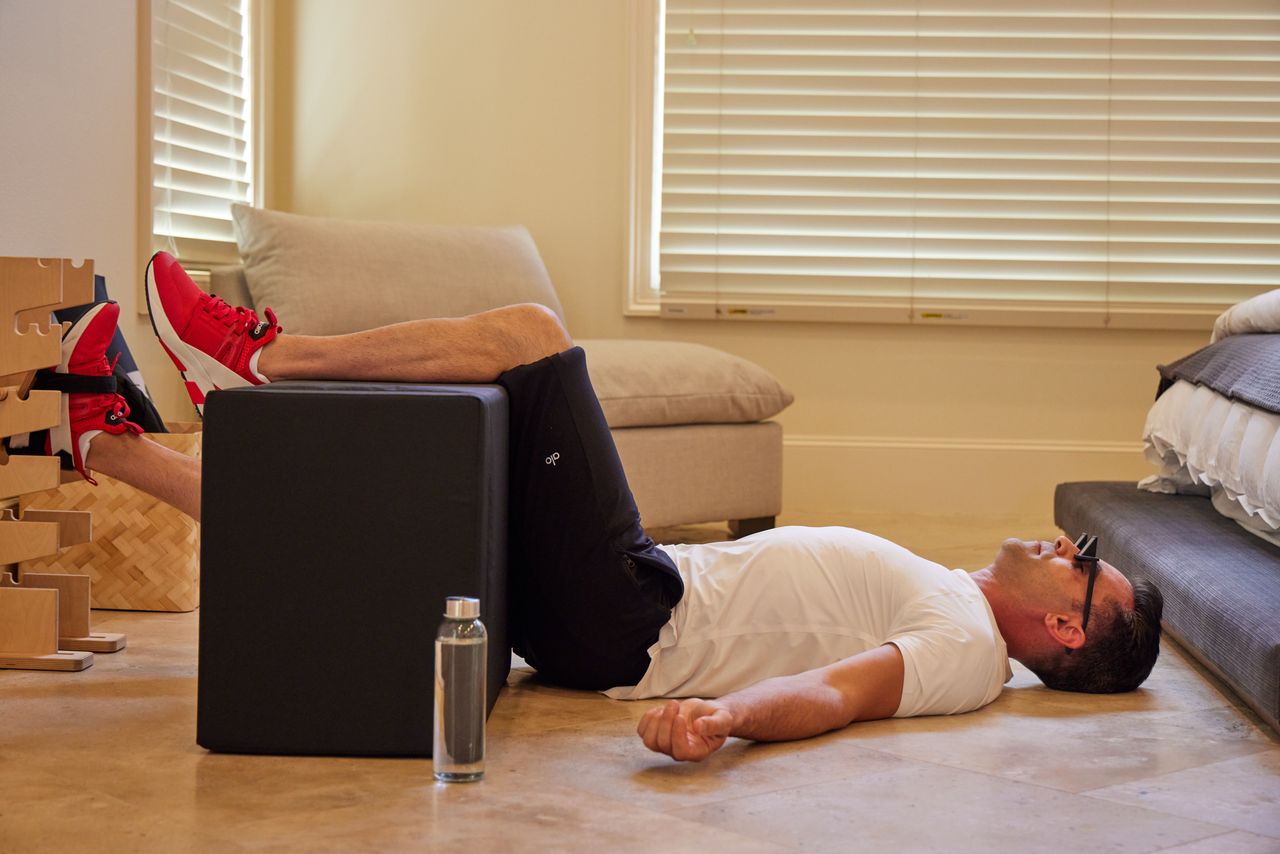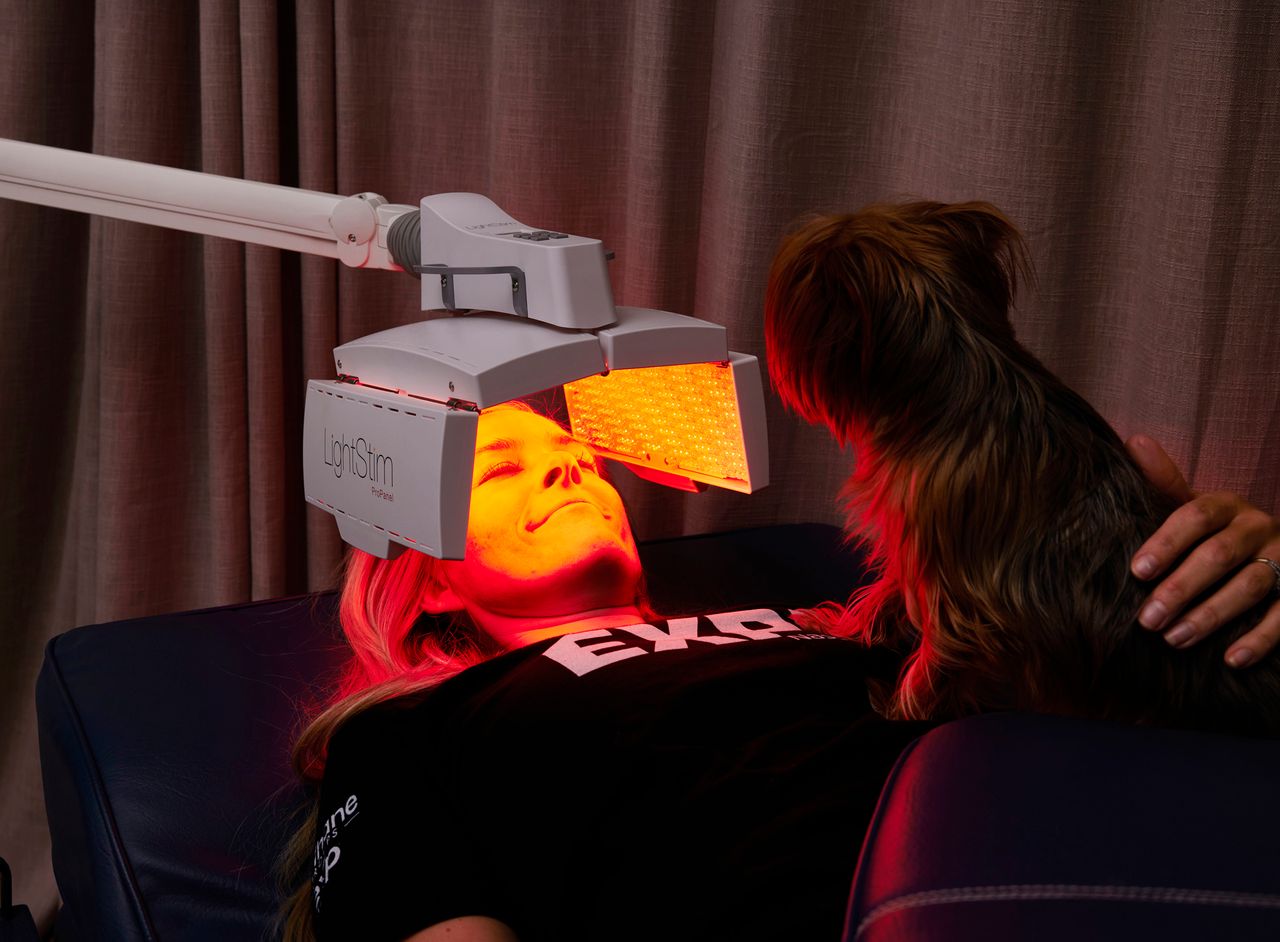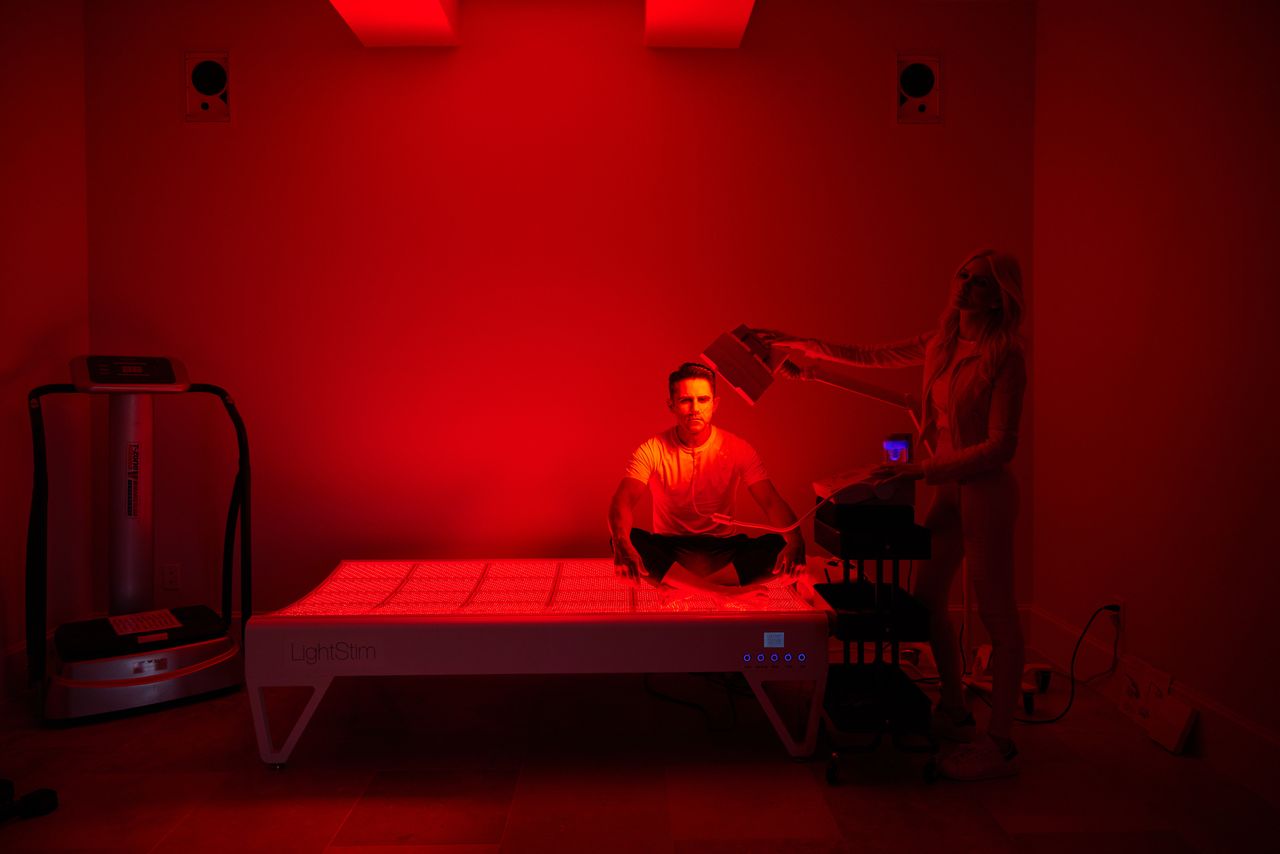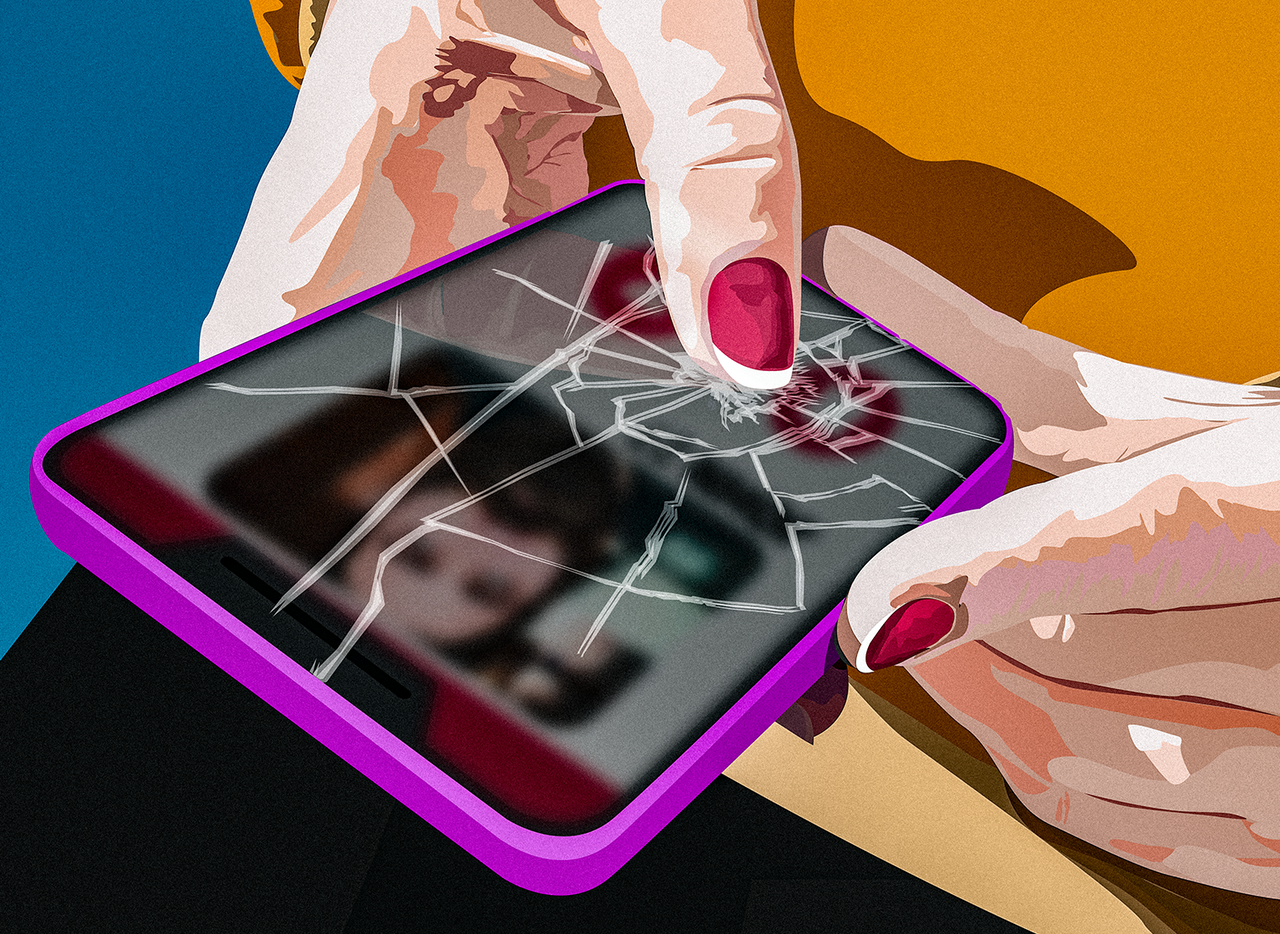The Biohacking Devotees Spending Hundreds of Thousands—Even Millions—to Enhance Their Homes
Light-therapy beds. Infrared saunas. Ozone generators. These homeowners have infused health and wellness into their properties, and then some
Real-estate investors Ari and Kellie Rastegar are devotees of biohacking, a wellness lifestyle aimed at optimising physical and mental performance. He takes 150 custom vitamins and supplements per day; she takes 23. They eat a diet specifically tailored to their genes. They workout with a trainer almost daily. They take posture management classes. They practice Transcendental Meditation. They say affirmations.
But their biohacking isn’t limited to their bodies. They’ve also biohacked their house, an 8,200-square-foot, $22,500-per-month rental in West Lake Hills, Texas, 6 miles from downtown Austin. “Biohacking is part of our life,” says Kellie Rastegar, 37. “You’d have to go out of your way to not biohack in our home.”
Gadgets are strategically positioned throughout their seven-bedroom, eight-bathroom space which they believe will help them achieve peak health and wellness. In the guts of their house are ultraviolet light systems for air and water purification. Their kitchen has a machine that adds hydrogen to their drinking water, providing hydration that Ari Rastegar says is “infinitely more powerful than normal water.” Their bedroom has a mattress pad cooled to 64 degrees Fahrenheit for him and 72 degrees for her. Their gym is outfitted with a machine that pumps extra oxygen into their bodies during training.
There are expensive devices, like a $65,000 light-therapy bed purported to provide training recovery and a $16,990 BioCharger machine that uses light, frequencies and harmonics, voltage and pulsed electromagnetic field technology to, its makers claim, promote cellular rejuvenation, enhance cellular health and revitalise the body. There are inexpensive tools—everything from a $350 inversion table for spinal decompression to $65 toe spacers for improved toe splay and alignment. All in, the Rastegars have spent roughly $135,000 biohacking their house, which they’ve lived in with their three children since 2021. “We’ve never owned our family home, ever,” says Ari Rastegar, noting that he doesn’t know where life is going to take his family. “I want to be able to move at the end of my lease if I want to.”

Ari Rastegar, 41, started biohacking around the time he and his wife co-founded Rastegar Property Company, in 2015. He said that his late-night-working, fast-food-eating lifestyle of his 20s and early 30s had caught up with him in the form of thinning hair, dark under-eye circles, weight issues and anxiety. An encounter with neurosurgeon Dr. Jacob Rosenstein changed his course: Rosenstein calibrated the Rastegars’ vitamins, minerals, diet and hormones, which began the couple’s biohacking journey.
Rastegar says adapting his house to support his biology is a necessary response to living in today’s world. “This is about giving myself an extra edge to show up for my kids, my wife, my clients and my staff,” says Rastegar, whose company owns, renovates, manages and develops commercial and residential properties across the U.S. “Does my skin end up looking better or whatever, too? Absolutely. But this is not an exercise in vanity. As an investor, shouldn’t I be asking: ‘How do I remodel me?’ ”
Biohacking became a buzzword around the time Silicon Valley entrepreneur Dave Asprey’s Bulletproof coffee, a.k.a. butter coffee, morphed into an energy-boosting lifestyle in the 2010s. Between then and now, biohacking has become an eclectic umbrella term encompassing everything from sleep journaling to hyperbaric oxygen therapy to human augmentation via device implantation. At the core of all biohacking, however, is one pursuit: Optimisation.
“Biohackers are looking to perform better physically or mentally using hacks,” says biohacking educator Lauren Berlingeri, co-founder of HigherDOSE, which creates at-home, self-care products that support biohacking, including wellness technology like infrared sauna blankets and red-light face masks. Her co-founder, Katie Kaps, describes a hack as receiving a disproportionate gain versus the effort put in. A straight-forward example of a hack, Kaps says, is relieving a bad hangover in 30-minutes with an IV drip.
It is difficult for medical doctors to assess biohacking’s scientific merits and safety due to biohacking’s extremely wide spectrum of tools and interventions. “The bottom line here is that someone familiar with your medical history is best equipped to advise you on whether something is safe for you,” says Dr. Jaclyn Tolentino, a Los Angeles-based senior doctor at the primary care practice Parsley Health. Dr. Tolentino appreciates that biohacking enables self-discovery. “But healthy is a relative term,” she says, noting that whether biohacking starts to veer into unhealthy territory is for each individual and their doctor to decide.
Technology entrepreneur Bryan Johnson, also known as Zero, has a team of doctors overseeing his pursuit as a “professional rejuvenation athlete.” Johnson, 45, through a project he calls Blueprint, is spending $2 million a year experimenting on himself with efforts to slow and reverse ageing. He says his five-bedroom, five-bathroom Los Angeles-area home is set up to support his quest, housing such medical-grade devices as an ultrasound system, skin-therapy devices, skin-measurement systems and infrastructure to collect blood. He also converted the garage into a gym. “It’s a good base camp for building something,” he says of his house, where 25% of his Blueprint experimentation happens; the other 75% takes place at medical facilities.
In north Scottsdale, Ariz., Brian Culhane, 48, and Kristi Culhane, 46, spent $3.5 million building a five-bedroom, six-bathroom house with 10,000 square feet of climate-controlled space. They’ve invested roughly $250,000 on at-home biohacking accoutrements, including a pool, spa, cold plunge, sauna with Himalayan salt, steam room with aromatherapy and light therapy, heated floors, a PEMF bed, an infrared machine and compression boots. Add the indoor basketball court into the tally, and the total biohacking expenditure pushes closer to $1 million.
“We spend quite a bit of money on biohacking, but we have to,” says Brian Culhane, who is the founding agent of cloud-based real-estate brokerage eXp Realty. “It’s keeping me alive. That’s how we look at it.”
In 2011, Culhane broke his hip in a bicycling accident. Thus began a long, circuitous and still-ongoing hip rehabilitation nightmare, which, in 2018, led him to start training with Troy Casey, a longevity guru based in Scottsdale, Ariz. Culhane says he inspired him to fully delve into biohacking. Culhane began traveling the world—at first by himself, and later with his wife—meeting with biohacking experts and visiting spas, until he had a realization. “I wanted to build a house into a huge training centre and bring everyone and everything to me,” he says.

The Culhanes were sitting on a 1.1-acre land parcel they bought in 2018 for $546,500. In 2020, the Culhanes started building a spa-like, biohacking dream house. The project persevered through Covid-19 pandemic curveballs like difficulty getting a construction loan, the lumber shortage and the supply chain crisis—plus the couple’s own stock-portfolio fluctuations—before the Culhanes, who have three children, finished construction in late 2022.
Brian Culhane’s biohacking protocol varies day-to-day. Some days he might lie in his PEMF bed while using infrared light, wearing compression boots and receiving supplemental oxygen and IV nicotinamide adenine dinucleotide (NAD) drips—a combination that leaves him, he says, “feeling jacked.” Other days, he might engage in at-home ozone therapy or stem cell shots.
Everyday, however, Culhane aspires to do the same morning routine with his wife, which includes waking up at 4:45 a.m. followed by praying, meditating and doing thought projecting; making the bed and drinking a half-cup of coffee; taking amino acid supplements; honouring the morning sunrise; doing a 30- to 45-minute workout or heavy qigong; taking a 10-minute, very hot 194 degree Fahrenheit sauna while doing breathwork; taking a 3- to 5- minute, very cold 39 degree Fahrenheit cold plunge; taking a 3- to 5- minute hot-tub dip; taking a 3- to 5- minute steam while doing breathwork focused on vocal vibrations and lymphatic draining; rinsing off in the cold plunge; drinking a green shake and taking prebiotics and more supplements; getting the kids off to school by 7:45 a.m.; doing some kind of movement like going to the gym, walking, hiking, or biking; and, finally, recovering.
“Why not build a house where you can do these things?” Brian Culhane asks. “You spend so much time at home. Your house should heal you. It should nourish you. It should rejuvenate you. It shouldn’t kill you.”
At a basic level, biohackers are onto something: Air quality, water quality and light are the top elements of indoor wellness as validated by the WELL Building Standard, a global certification used to assess a building’s effect on occupant health. The standard was launched in 2014 by New York-based company Delos and backed by research contributed by such institutions as Mayo Clinic and Cleveland Clinic. The company’s founder and CEO Paul Scialla says sufficiently improving indoor air, water and lighting can be done for 1% of construction costs or less. “It doesn’t have to break the bank,” he says.
Considering the built environment is the approach Luke Storey, 52, took when he and his wife, Alyson Charles Storey, 44, gut renovated their 3,500-square-foot house in Texas Hill Country, about 30 minutes from downtown Austin. Storey says people call him a biohacker even though he doesn’t like the word. “The term has a reductionist, mechanistic view of the body and a person’s relationship with it,” says Storey, who is a wellness expert, spiritual guide and the Life Stylist Podcast host. “I relate to my body as an intelligent organism, but there isn’t a catchy term for that.”
The Storeys bought their now five-bedroom, three-bathroom space for $865,000 in 2021. During inspection, they discovered a dreaded wellness foe: Mould. It required the demolition of the bathroom sinks, laundry room and kitchen sink. The Storeys had been considering a less-substantial renovation, but in remediating the mould, they decided to dream bigger and to spend $500,000 creating what Storey calls a sacred healing temple.
Storey estimates there is about $150,000 in biohacking technology in the house, including an ice bath, two infrared saunas, a hydrogen water machine, a molecular hydrogen gas generator, a red-light-therapy machine, an ozone generator and PEMF devices. But making room for equipment was a secondary renovation objective. The primary goal was to replicate the natural world indoors as much as possible, what Storey refers to as creating an ancestral environment.
There are air purifiers in the HVAC system and around the house. Water goes through two purification systems; there is a separate drinking water station. White-blue light bulbs are used during the day to mimic the full spectrum of sunlight, and at night, only amber incandescent or solid red light bulbs are used—this includes orange or red landscape lighting to protect animals. There is red tape on every in-home blue light source, such as inside the fridge. Electromagnetic field (EMF)—invisible areas of energy—is reduced with ethernet wiring, WiFi with a manual on-off, an EMF kill switch in the main bedroom, EMF mitigating paint and EMF-harmonising devices and quantum energy generators.
Storey concedes that not all houses need all these things. “I go the extra mile because I’m just extra, that’s who I am,” he says. “A lot of this might sound crazy or extreme to some people.”
“To me,” he adds, “this is just basic biology.”
 Copyright 2020, Dow Jones & Company, Inc. All Rights Reserved Worldwide. LEARN MORE
Copyright 2020, Dow Jones & Company, Inc. All Rights Reserved Worldwide. LEARN MORE
This stylish family home combines a classic palette and finishes with a flexible floorplan
Just 55 minutes from Sydney, make this your creative getaway located in the majestic Hawkesbury region.
Ahead of the Games, a breakdown of the city’s most desirable places to live
PARIS —Paris has long been a byword for luxurious living. The traditional components of the upscale home, from parquet floors to elaborate moldings, have their origins here. Yet settling down in just the right address in this low-rise, high-density city may be the greatest luxury of all.
Tradition reigns supreme in Paris real estate, where certain conditions seem set in stone—the western half of the city, on either side of the Seine, has long been more expensive than the east. But in the fashion world’s capital, parts of the housing market are also subject to shifting fads. In the trendy, hilly northeast, a roving cool factor can send prices in this year’s hip neighborhood rising, while last year’s might seem like a sudden bargain.
This week, with the opening of the Olympic Games and the eyes of the world turned toward Paris, The Wall Street Journal looks at the most expensive and desirable areas in the City of Light.
The Most Expensive Arrondissement: the 6th
Known for historic architecture, elegant apartment houses and bohemian street cred, the 6th Arrondissement is Paris’s answer to Manhattan’s West Village. Like its New York counterpart, the 6th’s starving-artist days are long behind it. But the charm that first wooed notable residents like Gertrude Stein and Jean-Paul Sartre is still largely intact, attracting high-minded tourists and deep-pocketed homeowners who can afford its once-edgy, now serene atmosphere.
Le Breton George V Notaires, a Paris notary with an international clientele, says the 6th consistently holds the title of most expensive arrondissement among Paris’s 20 administrative districts, and 2023 was no exception. Last year, average home prices reached $1,428 a square foot—almost 30% higher than the Paris average of $1,100 a square foot.
According to Meilleurs Agents, the Paris real estate appraisal company, the 6th is also home to three of the city’s five most expensive streets. Rue de Furstemberg, a secluded loop between Boulevard Saint-Germain and the Seine, comes in on top, with average prices of $2,454 a square foot as of March 2024.
For more than two decades, Kyle Branum, a 51-year-old attorney, and Kimberly Branum, a 60-year-old retired CEO, have been regular visitors to Paris, opting for apartment rentals and ultimately an ownership interest in an apartment in the city’s 7th Arrondissement, a sedate Left Bank district known for its discreet atmosphere and plutocratic residents.
“The 7th was the only place we stayed,” says Kimberly, “but we spent most of our time in the 6th.”
In 2022, inspired by the strength of the dollar, the Branums decided to fulfil a longstanding dream of buying in Paris. Working with Paris Property Group, they opted for a 1,465-square-foot, three-bedroom in a building dating to the 17th century on a side street in the 6th Arrondissement. They paid $2.7 million for the unit and then spent just over $1 million on the renovation, working with Franco-American visual artist Monte Laster, who also does interiors.
The couple, who live in Santa Barbara, Calif., plan to spend about three months a year in Paris, hosting children and grandchildren, and cooking after forays to local food markets. Their new kitchen, which includes a French stove from luxury appliance brand Lacanche, is Kimberly’s favourite room, she says.
Another American, investor Ashley Maddox, 49, is also considering relocating.
In 2012, the longtime Paris resident bought a dingy, overstuffed 1,765-square-foot apartment in the 6th and started from scratch. She paid $2.5 million and undertook a gut renovation and building improvements for about $800,000. A centrepiece of the home now is the one-time salon, which was turned into an open-plan kitchen and dining area where Maddox and her three children tend to hang out, American-style. Just outside her door are some of the city’s best-known bakeries and cheesemongers, and she is a short walk from the Jardin du Luxembourg, the Left Bank’s premier green space.
“A lot of the majesty of the city is accessible from here,” she says. “It’s so central, it’s bananas.” Now that two of her children are going away to school, she has listed the four-bedroom apartment with Varenne for $5 million.
The Most Expensive Neighbourhoods: Notre-Dame and Invalides
Garrow Kedigian is moving up in the world of Parisian real estate by heading south of the Seine.
During the pandemic, the Canada-born, New York-based interior designer reassessed his life, he says, and decided “I’m not going to wait any longer to have a pied-à-terre in Paris.”
He originally selected a 1,130-square-foot one-bedroom in the trendy 9th Arrondissement, an up-and-coming Right Bank district just below Montmartre. But he soon realised it was too small for his extended stays, not to mention hosting guests from out of town.
After paying about $1.6 million in 2022 and then investing about $55,000 in new decor, he put the unit up for sale in early 2024 and went house-shopping a second time. He ended up in the Invalides quarter of the 7th Arrondissement in the shadow of one Paris’s signature monuments, the golden-domed Hôtel des Invalides, which dates to the 17th century and is fronted by a grand esplanade.
His new neighbourhood vies for Paris’s most expensive with the Notre-Dame quarter in the 4th Arrondissement, centred on a few islands in the Seine behind its namesake cathedral. According to Le Breton, home prices in the Notre-Dame neighbourhood were $1,818 a square foot in 2023, followed by $1,568 a square foot in Invalides.
After breaking even on his Right Bank one-bedroom, Kedigian paid $2.4 million for his new 1,450-square-foot two-bedroom in a late 19th-century building. It has southern exposures, rounded living-room windows and “gorgeous floors,” he says. Kedigian, who bought the new flat through Junot Fine Properties/Knight Frank, plans to spend up to $435,000 on a renovation that will involve restoring the original 12-foot ceiling height in many of the rooms, as well as rescuing the ceilings’ elaborate stucco detailing. He expects to finish in 2025.
Over in the Notre-Dame neighbourhood, Belles demeures de France/Christie’s recently sold a 2,370-square-foot, four-bedroom home for close to the asking price of about $8.6 million, or about $3,630 a square foot. Listing agent Marie-Hélène Lundgreen says this places the unit near the very top of Paris luxury real estate, where prime homes typically sell between $2,530 and $4,040 a square foot.
The Most Expensive Suburb: Neuilly-sur-Seine
The Boulevard Périphérique, the 22-mile ring road that surrounds Paris and its 20 arrondissements, was once a line in the sand for Parisians, who regarded the French capital’s numerous suburbs as something to drive through on their way to and from vacation. The past few decades have seen waves of gentrification beyond the city’s borders, upgrading humble or industrial districts to the north and east into prime residential areas. And it has turned Neuilly-sur-Seine, just northwest of the city, into a luxury compound of first resort.
In 2023, Neuilly’s average home price of $1,092 a square foot made the leafy, stately community Paris’s most expensive suburb.
Longtime residents, Alain and Michèle Bigio, decided this year is the right time to list their 7,730-square-foot, four-bedroom townhouse on a gated Neuilly street.
The couple, now in their mid 70s, completed the home in 1990, two years after they purchased a small parcel of garden from the owners next door for an undisclosed amount. Having relocated from a white-marble château outside Paris, the couple echoed their previous home by using white- and cream-coloured stone in the new four-story build. The Bigios, who will relocate just back over the border in the 16th Arrondissement, have listed the property with Emile Garcin Propriétés for $14.7 million.
The couple raised two adult children here and undertook upgrades in their empty-nester years—most recently, an indoor pool in the basement and a new elevator.
The cool, pale interiors give way to dark and sardonic images in the former staff’s quarters in the basement where Alain works on his hobby—surreal and satirical paintings, whose risqué content means that his wife prefers they stay downstairs. “I’m not a painter,” he says. “But I paint.”
The Trendiest Arrondissement: the 9th
French interior designer Julie Hamon is theatre royalty. Her grandfather was playwright Jean Anouilh, a giant of 20th-century French literature, and her sister is actress Gwendoline Hamon. The 52-year-old, who divides her time between Paris and the U.K., still remembers when the city’s 9th Arrondissement, where she and her husband bought their 1,885-square-foot duplex in 2017, was a place to have fun rather than put down roots. Now, the 9th is the place to do both.
The 9th, a largely 19th-century district, is Paris at its most urban. But what it lacks in parks and other green spaces, it makes up with nightlife and a bustling street life. Among Paris’s gentrifying districts, which have been transformed since 2000 from near-slums to the brink of luxury, the 9th has emerged as the clear winner. According to Le Breton, average 2023 home prices here were $1,062 a square foot, while its nearest competitors for the cool crown, the 10th and the 11th, have yet to break $1,011 a square foot.
A co-principal in the Bobo Design Studio, Hamon—whose gut renovation includes a dramatic skylight, a home cinema and air conditioning—still seems surprised at how far her arrondissement has come. “The 9th used to be well known for all the theatres, nightclubs and strip clubs,” she says. “But it was never a place where you wanted to live—now it’s the place to be.”
With their youngest child about to go to college, she and her husband, 52-year-old entrepreneur Guillaume Clignet, decided to list their Paris home for $3.45 million and live in London full-time. Propriétés Parisiennes/Sotheby’s is handling the listing, which has just gone into contract after about six months on the market.
The 9th’s music venues were a draw for 44-year-old American musician and piano dealer, Ronen Segev, who divides his time between Miami and a 1,725-square-foot, two-bedroom in the lower reaches of the arrondissement. Aided by Paris Property Group, Segev purchased the apartment at auction during the pandemic, sight unseen, for $1.69 million. He spent $270,000 on a renovation, knocking down a wall to make a larger salon suitable for home concerts.
During the Olympics, Segev is renting out the space for about $22,850 a week to attendees of the Games. Otherwise, he prefers longer-term sublets to visiting musicians for $32,700 a month.
Most Exclusive Address: Avenue Junot
Hidden in the hilly expanses of the 18th Arrondissement lies a legendary street that, for those in the know, is the city’s most exclusive address. Avenue Junot, a bucolic tree-lined lane, is a fairy-tale version of the city, separate from the gritty bustle that surrounds it.
Homes here rarely come up for sale, and, when they do, they tend to be off-market, or sold before they can be listed. Martine Kuperfis—whose Paris-based Junot Group real-estate company is named for the street—says the most expensive units here are penthouses with views over the whole of the city.
In 2021, her agency sold a 3,230-square-foot triplex apartment, with a 1,400-square-foot terrace, for $8.5 million. At about $2,630 a square foot, that is three times the current average price in the whole of the 18th.
Among its current Junot listings is a 1930s 1,220-square-foot townhouse on the avenue’s cobblestone extension, with an asking price of $2.8 million.
This stylish family home combines a classic palette and finishes with a flexible floorplan
Just 55 minutes from Sydney, make this your creative getaway located in the majestic Hawkesbury region.






















